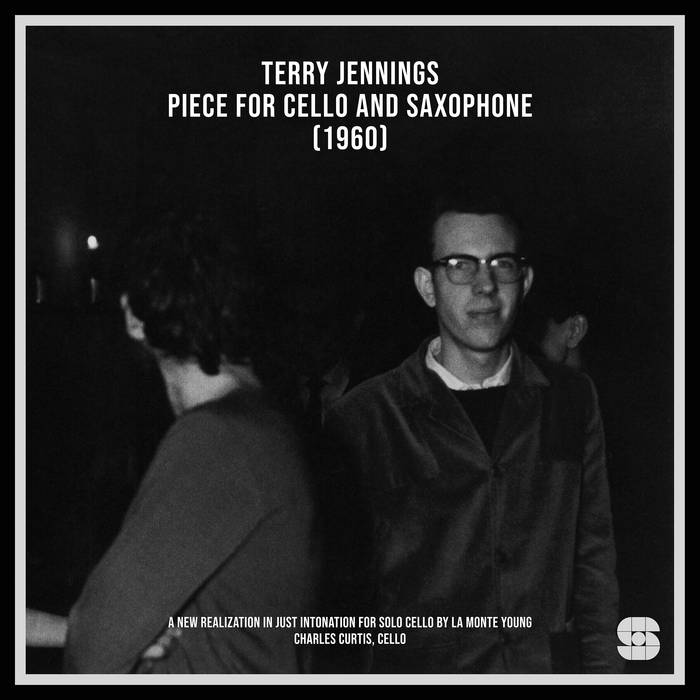We’re proud to announce the release of Terry Jennings Piece for Cello and Saxophone, which was performed by Charles Curtis on March 26 at Courtisane Festival 2016. I first learned about the piece through Alan Licht’s famous Minimalist Music lists and then, after having worked with Charles Curtis on several occasions (for his renderings of Eliane Radigue’s music), was finally able to commission him to play it live at the festival. The piece, Recorded by Ludo Engels at the time, was finally released in July 2022 on Saltern records, run by Tashi Wada.
This is a text Charles wrote by way of introduction to the performance:
In La Monte Young’s re-imagining of Terry Jennings’ Piece for Cello and Saxophone, the most prominent change is the placing of the piece in a Just Intonation tuning. Even though Jennings conceived the piece in equal temperament, it’s notable that the chords are held in continuous sustained tones, that Jennings specifies these tones be held without vibrato, and that the melodic figures over the sustained cello tones repeat in very specific constellations. It is impossible for me to imagine this music being played – or heard – without a focus on the complex acoustical experience of sustained intervals, and thus the move to put these intervals into rational relationships seems near at hand.
At the same time the music reads, up to a point, as tonal, resolving and diverging and resolving again, moving gradually between E and A as formal centers, with various transit points in between as modulating fulcrums. I hear the chord progressions as chorale-like, but set forth in very slow motion. One is confronted then with a variable listening situation, in which one can dwell on the concrete, physical, purely acoustical richness of the Just Intonation structures; or one can switch over to a listening mode which addresses the chordal progressions, the quasi-functional relationships of the melody notes to the chords – suspensions, major/minor shifts, the like – and the accumulated associations with earlier music thus evoked. Some of the beauty of the piece may be in the polymorphous status of the listening experience.
Now that the piece exists in La Monte Young’s tuning, the style of performance has shifted to careful attention on the placement of the intervals. The melodic unfolding slows down naturally – and it is fair to guess that this would have pleased Jennings – as the performer constantly seeks to identify the combination tones, partials and slight beatings which act as orientation points. In Just Intonation, a note is not a simple mark or a neutral point in a scale, but rather an entryway into a severely defined virtual space. The location of the entryway can never be assumed, but must be sought, again and again, with each motion from frequency to frequency. This constantly-seeking and never-knowing lends the piece a special expressivity – even “musicality” – quite different from the assured, florid pattern-improvisation that Jennings himself might have employed.
Jennings provides extensive directions for the articulation of the melodic patterns, but his directions are ambiguous, at best. One of his directions states: “Since Directions 3 + 4 seem confusing why don’t you listen to the tape recording of the piece and may be change the directions accordingly.” Yet there is no known recording of the complete piece. In essence the directions lay out the melodic unfolding of a finite pitch set over changing sustained tones, explaining which groups to repeat and when to shift forward and no longer repeat earlier patterns. The piece moves forward by lingering upon a present pattern, with reference to earlier patterns or tones allowed under certain conditions, and new tones occurring as a signal to move on to the next set of patterns. Over time one has the sensation of a filling-in, a gradual completion of elements only hinted at in the beginning. The sense then would be that all elements remain, that as the piece moves forward none of the preceding music actually falls away, nothing is discarded, nothing is forgotten; the structure builds, and lingers.
Terry Jennings remains a shadowy figure, a fleeting presence in music history, leaving few material traces of his work; yet he was revered by those who knew him. His works too, especially the beautiful solo piano pieces such as Winter Trees and the Piano Piece published in La Monte Young’s An Anthology, are slight, bare, fragile moments in early Minimalism. Piece for Cello and Saxophone, by contrast, seems a more formally ambitious work. Even if they’re confusing, the lengthy directions may point to Jennings’ concern for a more legible and detailed music. In its present form, the piece is monumental, without, paradoxically, missing any of Jennings’ characteristic fragility and weightlessness. The tragedy and the promise of music is that it lives, and dies, again and again in the moment of its performance, fleeting and impermanent, but returning. This fact is rarely felt with greater poignancy than in Jennings’ music.
